Wisconsin Center Won’t Reconsider Removing Literary Artwork
CEO Marty Brooks emails board members to explain why.
Yesterday Urban Milwaukee reported that the Wisconsin Center District will be destroying a permanent installation of literary artwork in the convention center that was installed in 1998 with texts from 48 different Wisconsin writers going back hundreds of years.
The public art work was created under the leadership of the Milwaukee Arts Board, with support from then-Mayor John Norquist and included texts from such famous Wisconsin writers as Laura Ingalls Wilder, John Muir, Zona Gale, Aldo Leopold, Edna Ferber, Glenway Westcott, Lorine Niedecker and Carl Sandburg (from the years when the poet lived in Milwaukee).
“It is a live, on-the-wall anthology that is not duplicated anywhere in the country, as far as we know, where writing is treated as being just as important as any other art form,” said Karl Gartung, who served as artistic director of the nonprofit book store and arts center Woodland Pattern, which was involved in the year-long process of finding and selecting the texts.
Because the work was permanently installed, it cannot be removed in any way that will preserve it. The work will be destroyed in the process of removing it.
“It seems like an act of cultural vandalism,” Gartung says.
The decision to remove the works was made by Marty Brooks, CEO for the Wisconsin Center and was never reviewed by the Wisconsin Center’s board of directors, said Milwaukee Alderman Bob Bauman, a member of the board. “It has never been reported to the board or debated or voted on,” he said.
Brooks was asked for comment by Urban Milwaukee yesterday morning, and his vice-president of marketing and communications, Sarah Maio, said he was too busy to respond. Maio confirmed that the board hadn’t been consulted but noted that the board’s approval of the 2020 resolution to approve expansion “authorized the CEO to manage and mitigate every decision and challenge” of the expansion.
Brooks, meanwhile, sent an email yesterday afternoon to board members saying that some art in the south building was being decommissioned in order to keep a “keen focus on maintaining visual cohesion between the north and south buildings.” Urban Milwaukee had reached out to many public officials from the board seeking comment.
Brooks letter also noted that artists were informed that their work was was being decommissioned and “Some artists chose to collect their works, others not.”
Except that the literary art work was created in such a way that it cannot be preserved or collected.
In response to Brooks email yesterday Bauman emailed Brooks and some fellow board members to say this: “I would strongly urge you to delay this demolition and destruction and present the issue to the board for review and approval. I cannot see any harm in doing so. I would like to see this exhibit for myself before deciding. I suspect other board members would concur.”
But Brooks was unmoved. Bauman says Brooks “definitely didn’t offer to have a meeting about it.”
Photos
If you think stories like this are important, become a member of Urban Milwaukee and help support real, independent journalism. Plus you get some cool added benefits.
More about the Wisconsin Center District Literary Arts Installation Controversy
- ‘Polka Time!’ Escalator Gets Celebratory Sendoff - Sophie Bolich - Aug 18th, 2023
- Wisconsin Center Makes Deal to Save Literary Artwork - Bruce Murphy - May 1st, 2023
- Back in the News: Wisconsin Center Dispute Goes National - Bruce Murphy - Apr 25th, 2023
- Murphy’s Law: Did Brooks Exceed His Authority At Wisconsin Center? - Bruce Murphy - Apr 18th, 2023
- Wisconsin Center Pauses Art Removal - Jeramey Jannene - Apr 14th, 2023
- Revised Letter to Wisconsin Center District CEO Marty Brooks - Press Release - Apr 11th, 2023
- Back in the News: Wisconsin Center Accused of Censorship - Bruce Murphy - Apr 11th, 2023
- Back in the News: Wisconsin Center Won’t Reconsider Removing Literary Artwork - Bruce Murphy - Apr 5th, 2023
- Murphy’s Law: Wisconsin Center Will Destroy Literary Artworks - Bruce Murphy - Apr 4th, 2023
Read more about Wisconsin Center District Literary Arts Installation Controversy here
Back in the News
-
Justice Ziegler Misquotes US Supreme Court Decision
 Dec 2nd, 2025 by Bruce Murphy
Dec 2nd, 2025 by Bruce Murphy
-
Will West Milwaukee Do Development Near Brewers Stadium?
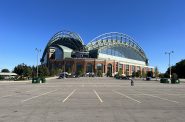 Dec 1st, 2025 by Bruce Murphy
Dec 1st, 2025 by Bruce Murphy
-
Key Streetcar Opponent Opposes Effort to Shut It Down
 Nov 10th, 2025 by Bruce Murphy
Nov 10th, 2025 by Bruce Murphy


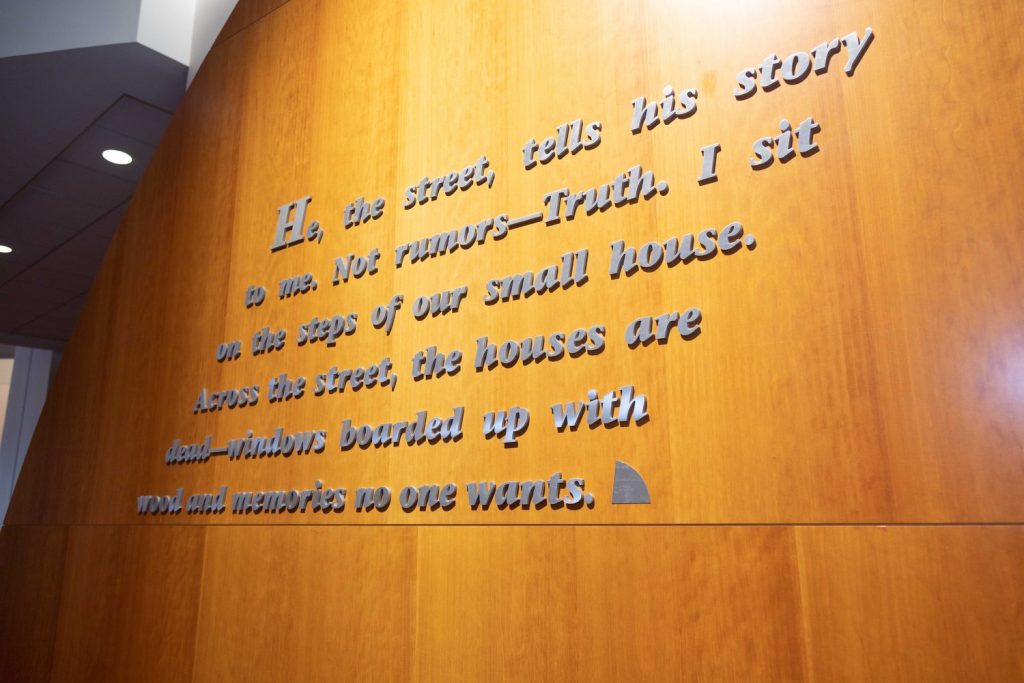
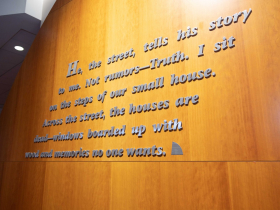
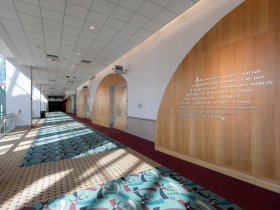

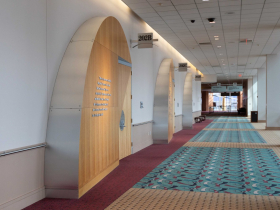
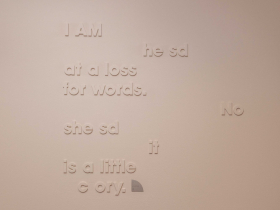
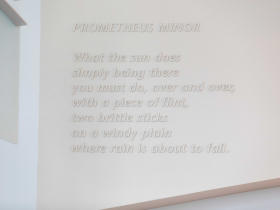




















This planned destruction of a massive public installation, known for its grace and beauty, is progressing with absolutely no transparency, including of its considerable tax-funded budget. Thus, these 11th-hour musings seem as ephemeral and moot as this now-casually-devalued art.
What might Milwaukeeans learn from yet-another wanton cultural erasure? What may be the long-term impacts of abdicating accountability–and privatizing decisions–about what were created as public goods? Why do we tolerate treating taxpayers merely as faceless funders–with no actual stake and undeserving of any respect or input?
A recent newcomer with influence has maneuvered, in secret, to destroy a major chronicle of Wisconsin culture–including significant Indigenous storytelling—within our civic center. (Conquerors often smash culture; stewards do not.) Among the unseen rubble will be all the thoughtful community engagement and wisdom, spanning years, that informed this work. Chief Black Hawk (1767-1838) is among those represented who will be summarily removed from these walls.
Tourists are drawn to places for their distinctive and authentic character, not their sanitized, white-washed blandness. Unilateral shredding of ancestral legacies seems a dubious enterprise, whether or not one calls oneself a public servant.
What’s missing in all this is the ‘why’? Why would you want to destroy art, much less art that adds much appreciated cultural definition and meaning? I don’t get it.
@ Virginia small –
Q: “What might Milwaukeeans learn from yet-another…”
A: Who needs to be kept away from the levers of power.
I encourage readers to check out Murphy’s original piece on this subject that appeared April 4: https://urbanmilwaukee.com/2023/04/04/murphys-law-wisconsin-center-will-destroy-literary-artworks/
There are many insightful comments following the story that are worth reading.
As I peruse those latest comments it occurs to me that considering the limitations of scale, visibility, and weather sensitivity of this art installation, it might actually be better to recreate it in a more manageable format at another heavily traversed and readily accessible location. I cannot fathom that there is not a private/public partnership that could make this happen. It’s way too important to preserve this valuable piece of Wisconsin literary heritage.
And if you don’t think our literary history as art is important, think of well-known quotes that have inspired, educated, consoled, uplifted, and/or amused you.
For the record, this project is “the country’s largest public installation of literary works,” according to Woodland Pattern. Works are located on two floors and some can be viewed from multiple vantage points.
The following are represented in the project: Folami Abiade, Antler, Martha Bergland, Kimberly Blaeser, Black Sparrow Hawk, Mountain Wolf Woman, the Ojibwe tribe, the Potowatomi tribe, Frances Brock Starms, B. J. Buhrow, Daisy Cubias, Susan Engberg, Edna Ferber, Zona Gale, Horace Gregory, James Hazard, Peggy Hong, Laura Ingalls Wilder, Ellen Kort, Margery Latimer, Aldo Leopold, Joel Lipman, Ben Logan, Charles McClain, Juliette Magill Kinzie, Anja Malesa, Tom Montag, Lorrie Moore, Kyoko Mori, John Muir, Lorine Niedecker, Louise Phelps Kellogg, Carl Rakosi, R. M. Ryan, Carl Sandburg, Guadalupe Solis, Denise Sweet, Bruce Taylor, Larry Watson, Glenway Wescott, J. D. Whitney, and Karl Young.
The works relating to Indigeneity were curated by Dr. Kimberly Blaeser (Anishinaabe) a former Wisconsin Poet Laureate and current professor at UWM and MFA faculty member at the Institute for American Indian Art in Santa Fe. She is the founding director of In-Na-Po (Indigenous Nations Poets), a national Indigenous poetry community that supports emerging writers and Indigenous poetic practices.
Clearly, Marty Brooks is just being a jerk about the whole thing. If he would have taken this to the board earlier–and not waited until Bruce aimed a little sunshine on the matter–it likely could have been dealt with. (As an aside, I’m totally aligned with Alder Bauman on this, and that rarely happens!) 😉
I suspect there is a legitimate “why” for decommissioning the art and renovating the space in light of the current expansion. That’s a the risk with an installation that was integrated into the building design, a building that was designed to be expanded from day one. And, frankly, after looking more into the work and understanding its message, I think it’s totally in the wrong place, anyway. This is public art that deserves to be much more public.
Moving forward, my want is for everyone to hold Brooks’s feet to the fire, for all public oversight to be mobilized, and for a plan to be drawn up for a reimagination and relocation of this work. (Does it even have a name? It doesn’t on Jill Sebastian’s website.) Maybe the location of the nascent Lakefront Gateway project? The space just east of MGIC? Incorporated into MAM’s plans for its new sculpture garden at the foot of Wisconsin Ave.? Maybe Ziedler Union Square with all the new development on Michigan Street?
Who would pay for something like this? Well, maybe Brooks can help foot the bill along with some of MKE’s more generous civic supporters.
BTW, and for the record, Sebastian generously acknowledges on her site the many collaborators involved in this work’s creation: “a tight working relationship with the architects Ventulett, Thompson & Stainback and Engberg Anderson Design… Collaborating with Woodland Pattern Book Center and a panel of seven experts.
http://jillsebastian.com/
Last note: Sebastian may almost be getting used to this. In 2015, Madison removed her Philosophers’ Stones work after calls from area businesses and due to increased vandalism and crime:
https://www.cityofmadison.com/council/district2/blog/?Id=7811
https://heron-grape-lhzp.squarespace.com/philosophers-stones
Public art!
For 45 years I ran a model, prop, and prototyping
studio. We also created custom “finesse” works for
several architectural projects.
I can’t believe that all these works are irretrievable.
Has anyone contacted the artists?
Many of these works make much more sense
with the “finesse work” done in the studio.
Prior to the finesse work, a prefitted panel
would be made on site, taken back to the studio
for finishing, then delivered prepainted, mounting means
and parts provided. If the creator is not the installer,
a face-to-face briefing would be held, preferably with the
architect’s representative. construction crew,
and the foreman.
This smooths out the logistics, and reduces traffic
and the number of people on site, plus the risk of
damage to uninstalled work.
Insurance companies love that.
It takes a little more coordination, but
if the creator provides 2 quotes, one fabricating on-site,
the other fabricating in the studio, the price usually settles
the issue.
Back into the present – For works in which the creator can’t be located,
knuckle-rapping on the wall can give clues, as well as a
magnetic stud finder. To verify, a little exploratory surgery should be
done near the edges of content.
A little forensics now can avoid unnecessary work and
costs in the future, wherever the existing work is suitable
for the new installation.